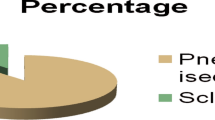Abstract
Temporal bone dissection has important role in educating, and training the surgeons. Temporal bone has complicated three dimensional anatomy and it is challenging for young surgeons to understand and operate. Not knowing the anatomy may cause serious consequences to patient due to injury to vital structures. It is important to learn temporal bone harvesting techniques, preservation of specimens, fixation and to reduce the health hazards posed by these specimens by taking safety measures. Spending more time in temporal bone laboratory and repeated dissection of temporal bones provides the skills necessary in the operating room for future generation. All training institutes should establish temporal bone laboratory in their department to provide the necessary expertise to future generation while maintaining safe and secure environment.




Similar content being viewed by others
References
Fennessy BG, O’Sullivan P (2009) Establishing a temporal bone laboratory: considerations for ENT specialist training. Ir J Med Sci 178:393–395
George AP, De R (2010) Review of temporal bone dissection teaching: how it was, is and will be. J Laryngol Otol 124:119–125
Walvekar RR, Harless LD, Loehn BC, Swartz W (2010) Block method of human temporal bone removal: a technical modification to permit rapid removal. Laryngoscope 120:1998–2001
Naik SM, Naik MS, Bains NK (2014) Cadaveric temporal bone dissection: Is it obsolete today? Int Arch Otorhinolaryngol 18:63–67
Wang H, Northrop C, Burgess B, Liberman MC, Merchant SN (2006) Three-dimensional virtual model of the human temporal bone: a stand-alone, downloadable teaching tool. Otol Neurotol 27:452–457
García JMM, Da Costa ASA, Schmitz TR, Estomba CMC, Zavarce MIH (2014) Commentary temporal bone dissection practice using a chicken egg. Otol Neurotol 35:941–943
Francis HW, Malik MU, Varela DADV, Barffour MA, Chien WW, Carey JP, Niparko JK, Bhatti NI (2012) Technical skills improve after practice on virtual-reality temporal bone simulator. Laryngoscope 122:1385–1391
Qiu MG, Zhang SX, Liu ZJ, Tan LW, Li QY, Li K, Wang YS, Deng JH, Tang Z-S (2004) Visualization of the temporal bone of the Chinese visible human. Surg Radiol Anat 26:149–152
Manolis E, Filippou D, Theocharis S, Panagiotaropoulos T, Lappas D, Mompheratou E (2007) Anatomical landmarks: dimensions of the mastoid air cell system in the Mediterranean population. Our experience from the anatomy of 298 temporal bones. Anat Sci Int 82:139–146
Zirkle M, Taplin MA, Anthony R, Dubrowski A (2007) Objective assessment of temporal bone drilling skills. Ann Otol Rhinol Laryngol 116(11):793–798
Gulya AJ, Minor LB, Poe DS (2010) Glasscock-Shambaugh Surgery of the ear. 6th edn. CBS Publishers & Distributors, New Delhi, pp 779–780
Fisch U and Mattox D (1988) Atlas on Microsurgery of the skull base. Thieme Medical Publisher, New York, p 10
Kylen P, Stjernvall J-E, Arlinger S (1977) Variables affecting the drill-generated noise levels in ear surgery. Acta Otolaryngol 84:252–259
Supplements The Bombay Anatomy Act, 1949.[As modified up to 10th November 1997]. J Indian Acad Forensic Med 31(2). medind.nic.in/jal/t09/i2/jalt09i2p176
Author information
Authors and Affiliations
Corresponding author
Ethics declarations
Conflict of interest
All the authors have no conflict of interest.
Ethical Standard
This article does not contain any studies with human participants or animals performed by any of the authors.
Rights and permissions
About this article
Cite this article
Irugu, D.V.K., Singh, A.C., Sikka, K. et al. Establishing a Temporal Bone Laboratory in Teaching Institutes to Train Future Otorhinolaryngologists and Fundamentals of Temporal Bone Laboratory: Considerations and Requirements. Indian J Otolaryngol Head Neck Surg 68, 451–455 (2016). https://doi.org/10.1007/s12070-015-0962-0
Received:
Accepted:
Published:
Issue Date:
DOI: https://doi.org/10.1007/s12070-015-0962-0




